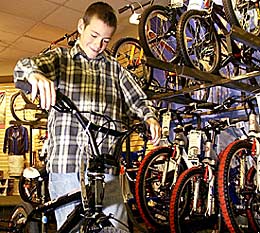|
Understanding BMX Bikes |
 |
One of the most popular children's bike categories is BMX, which stand for Bicycle Moto Cross. While people often throw around the BMX term generically, when you're shopping for one, it's important to understand that there are three different types of BMX bikes: the true BMX bike, the freestyle bike and the dirt jumper or just "jump" bike.
What's the difference between all these different types of BMX bikes? That's what we're here to explain. After you've read this article, visit a shop and check 'em out to see the differences yourself!
If you're not sure what BMX type your child wants, ask at the bicycle shop what type is popular in your area because the chances are good they'll know what's hottest with the kids. Or, you could ask your son or daughter's friends (if you think they can keep a secret).
What follows is a chart and descriptions of the three different BMX types with tips on how to select the right bike. It should ensure that the two-wheeler you pick is a hit with your child. If you're still not sure, keep in mind that most bicycle retailers will happily exchange gift bikes if they haven't been used. Ask about this before buying the bike to double check.
BMX Bike-Types Chart
|
Type |
Description |
Features |
Ideal Use |
|
BMX |
A dirt-ready quick-handling, race-worthy, rugged bike |
Knobby tires, lightweight frame and parts, strong rear brake |
Everything from around-town riding to short off-road rides to full-on dirt-track BMX racing |
|
Freestyle |
A super-sturdy stunt and trick bike |
Ultra-beefy frame and wheels, pavement-ready tires, cable-detangling headset, axle pegs |
Riding at skateparks, learning and performing stunts and tricks |
|
Jump |
Sometimes called a Dirt Jumper, these are essentially a fusion of BMX and freestyle bikes |
Sturdy frame and wheels, rear brake, knobby tires |
Carving local trails, jumping ramps in your friend's back yard |
True BMX bikes started it all, back in the late sixties. They were knockoffs of motocross motorcycles and were designed for racing over jumps and around berms in the dirt. Pretty soon kids everywhere had them, racers or not. BMX bikes are still designed for racing, although your child doesn't have to race to enjoy the light weight, speed and dirt-worthiness of these machines. In fact, lots of kids use theirs mainly for getting to school and back.
They usually have 20-inch wheels (24-inch-wheel "cruisers" are the exception), knobby tires, upright handlebars with crossbars, small saddles, long cranks and rear hand brakes. The frames are light and sturdy, and the higher the price, the lighter these bikes get.
BMX bikes are generally made of reliable chromoly steel or aluminum. Chromoly frames are a bit heavier and more economical. Aluminum frames are lighter and are often made of oversize or exotically shaped tubing. Besides weighing less, aluminum is also rustproof. So, if the frame gets scratched, there's no need to rush to touch it up.
BMX bikes also come in different frame sizes. The chart below shows the approximate fit based on rider age. Final fitting is best performed by the bicycle shop. Note that Pro and Expert bikes are sometimes available in XL (Extra Long) sizes as well.
|
Size |
Description |
Fits |
|
Mini |
Low standover height, 155-mm cranks, 20 x 1 1/8" tires |
4 to 6 years old |
|
Junior |
Slightly larger frame than Mini, 165-mm cranks, 20 x 1 3/8" tires |
6 to 9 years old |
|
Expert |
Longer top tube than Junior, 170-mm cranks, 20 x 1.5-1.75" tires |
9 to 13 years old |
|
Pro |
"Full-size" frame, 175-180-mm cranks, 20 x 1.75-2.2" tires |
12 and up |
Freestyle
These entered the scene shortly after BMX bikes. Rather than racing, the freestyle bike's ideal use is for flatland tricks, aggressive street riding and getting vertical at skateparks. It's also a great bike for riding to school, the store and the pool.
On these models super-sturdy construction is a higher priority than light weight, which makes them the parents' favorite. The wheels are usually either "mag" wheels made of sturdy nylon, or heavy-duty models with 48 wire spokes. The tires are 20 x 2.125 or wider, with fairly smooth treads, because they're predominantly pavement pounders. Axle pegs are often included (riders stand on them for stunts), although some manufacturers leave them off so kids can choose their own. Freestyle bikes come with front and rear brakes. The front cable is routed through a "rotor" or "detangler," which allows the handlebars to be spun completely around without tangling the brake cable.
Dirt Jumper
As the name implies, dirt jumpers (also known as jumpers) are designed for taking flight from kid-built and natural dirt mounds with an approach trail and landing area. These bikes bridge the gap between BMX bikes and freestylers (beefier than the former; lighter than the latter). They usually don't have front brakes and their brawny wheels normally feature 36 rugged 13-gauge spokes, rather than resorting to 48 spokes the way freestyle bikes do. They are occasionally equipped with 24-inch wheels, which are a great choice for larger riders. The tires have the most tread of any of the BMX types
If you have questions about the different types and what's appropriate for your child, the best way to learn more is to visit a bicycle retailer where you can see some different bikes to compare models. Let the dealer know what your child is riding now, how old and tall he is and where he likes to ride, and you'll be well on your way to getting the perfect gift.
